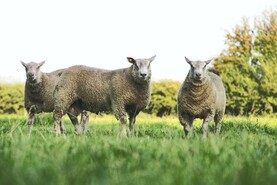Ewe condition
Last week’s sheep breeding focus discussed the importance of addressing ewe condition early to ensure you have ewes in top condition at joining with rams.
The topic was also prominent at last week’s Teagasc BETTER farm sheep walk on the mixed hill and upland farm walk of the Gonely family in Sligo.
Teagasc sheep specialist Damian Costello used a good example to prove his point, as detailed in Table 1.
Where an 80kg lowland ewe needs to lift by one condition score, offering preferential treatment nine weeks prior to breeding requires that sheep to gain 152g/day, which is an achievable feat.
If this is delayed until six weeks pre-breeding, then that will become 229g/day, which is a much trickier proposition. Delaying it until three weeks pre-joining with rams requires ewes to gain 457g/day, which there is no chance of achieving.
The figures are equally stark for hill breeding ewes, as they have a much lighter mature bodyweight and typically graze on much poorer-quality herbage.
The aim at this stage of the year is also to minimize grazing groups and start to build autumn grass supplies. Damian advised that where the number of ewes requiring preferential treatment is low, then adding them to a ewe lamb grazing group will address condition while keeping groups low.
He says that where ewes fail to gain condition despite preferential treatment, then such animals should be considered for culling, as there is likely to be an underlying problem such as a tooth issue or health concern.
It is also important to monitor the condition of ewes receiving preferential treatment and ewes being fed to maintenance requirements.
Purchasing rams
Breeding ram society and mart sales have kicked off, providing farmers with an opportunity to purchase rams early. There are two main advantages to doing so – access to a wider pool of top-performing genetics and allowing a longer period for rams to acclimatise to their new environment.
The optimal scenario is where rams are produced on a grass-based diet and transition seamlessly to their new surroundings.
Unfortunately, a high percentage of rams are produced on a high-energy diet, and as such to protect your investment it is generally best to offer concentrates for a transition period where volumes offered can be eased back.
Exploring the previous management will help in this regard, and also help avoid problems down the line with ram performance.






 This is a subscriber-only article
This is a subscriber-only article










SHARING OPTIONS: